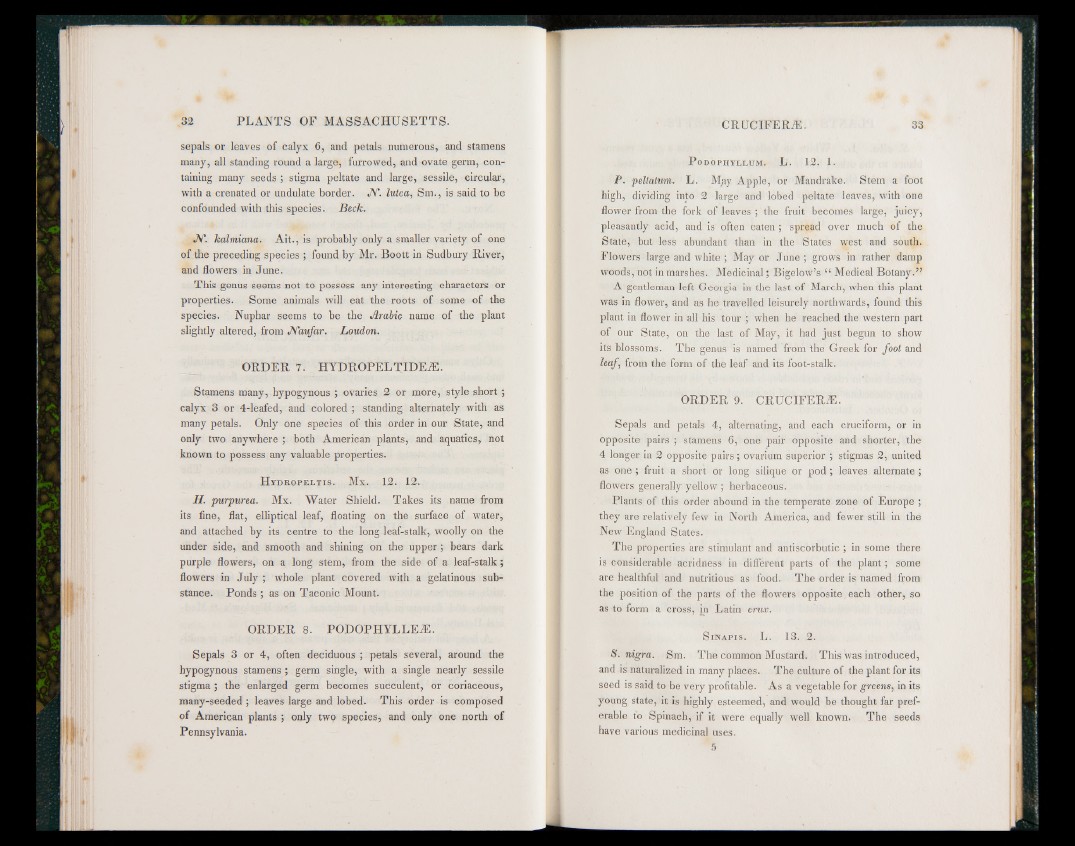
sepals or leaves of calyx 6, and petals numerous, and stamens
many, all standing round a large, furrowed, and ovate germ, containing
many seeds ; stigma peltate and large, sessile, circular,
with a crenated or undulate border. JV. lutea, Sm., is said to be
confounded with this species. Beck.
JV. kalmiana. Ait., is probably only a smaller variety of one
of the preceding species ; found by Mr. Boott in Sudbury River,
and flowers in June.
This genus seems not to possess any interesting characters or
properties. Some animals will eat the roots of some of the
species. Nuphar seems to be the Arabic name of the plant
slightly altered, from Naufar. Loudon.
ORDER 7. H YD RO PELTID EiE.
Stamens many, hypogynous ; ovaries 2 or more, style sh o rt;
calyx 3 or 4-leafed, and colored ; standing alternately with as
many petals. Only one species of this order in our State, and
only two anywhere ; both American plants, and aquatics, not
known to possess any valuable properties.
H tdropeltis. Mx. 12. 12.
H. purpurea. Mx. Water Shield. Takes its name from
its fine, flat, elliptical leaf, floating on the surface of water,
and attached by its centre to the long leaf-stalk, woolly on the
under side, and smooth and shining on the upper; bears dark
purple flowrers, on a long stem, from the side of a leaf-stalk;
flowers in July ; whole plant covered with a gelatinous substance.
Ponds ; as on Taconic Mount.
ORDER 8. PODOPHYLLEAi.
Sepals 3 or 4, often deciduous ; petals several, around the
hypogynous stamens ; germ single, with a single nearly sessile
stigma ; the enlarged germ becomes succulent, or coriaceous,
many-seeded ; leaves large and lobed. This order is composed
of American plants ; only two species, and only one north of
Pennsylvania.
P odophyllum. L . 12. 1.
P. peltatum. L. M,ay Apple, or Mandrake. Stem a foot
high, dividing into 2 large and lobed peltate leaves, with one
flower from the fork of leaves ; the fruit becomes large, juicy,
pleasantly acid, and is often eaten ; spread over much of the
State, but less abundant than in the States west and south.
Flowers large and white ; Mayor June; grows in rather damp
woods, not in marshes. Medicinal; Bigelow’s Is Medical Botany.”
A gentleman left Georgia in the last of March, when this plant
was in flower, and as he travelled leisurely northwards, found this
plant in flower in all his tour ; when he reached the western part
of our State, on the last of May, it had just begun to show
its blossoms. The genus is named from the Greek for foot and
leaf, from the form of the leaf and its foot-stalk.
ORDER 9. CRUCIFERJE.
Sepals and petals 4, alternating, and each cruciform, or in
opposite pairs ; stamens 6, one pair opposite and shorter, the
4 longer in 2 opposite pairs ; ovarium superior ; stigmas 2, united
as one ; fruit a short or long silique or po d ; leaves alternate ;
flowers generally yellow ; herbaceous.
Plants of this order abound in the temperate zone of Europe ;
they are relatively few in North America, and fewer still in the
New England States.
The properties are stimulant and antiscorbutic ; in some there
is considerable acridriess in different parts of the plant; some
are healthful and nutritious as food. The order is named from
the position of the parts of the flowers opposite each other, so
as to form a cross, jn Latin crux.
S inapis. L. 13. 2.
S. nigra. Sm. The common Mustard. This was introduced,
and is naturalized in many places. The culture of the plant for its
seed is said to be very profitable. As a vegetable for greens, in its
young state, it is highly esteemed, and would be thought far preferable
to Spinach, if it were equally well known. The seeds
have various medicinal uses.
5